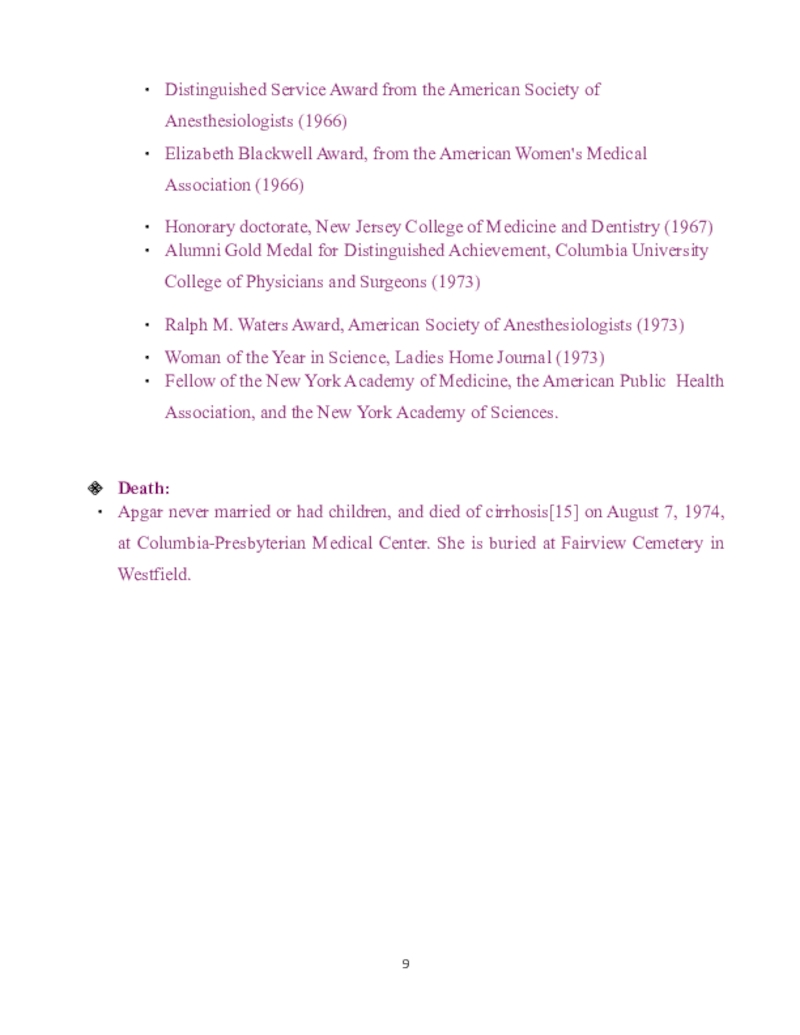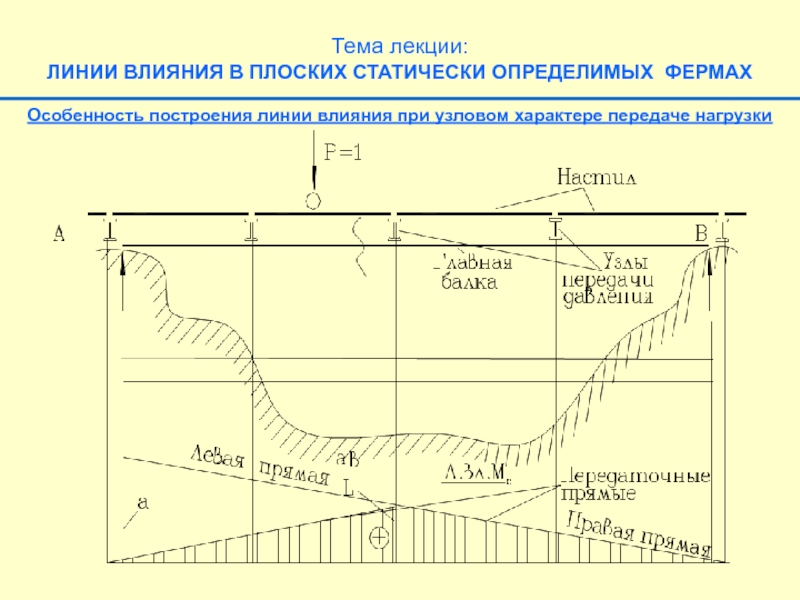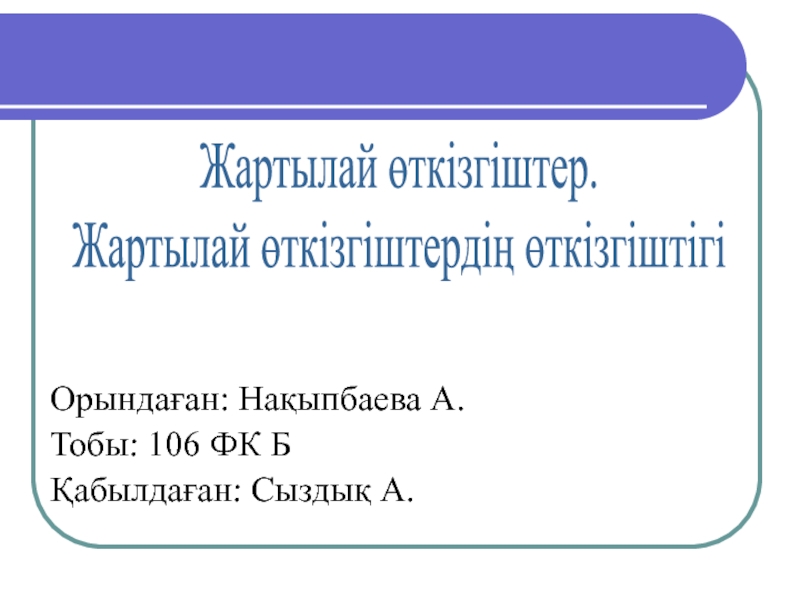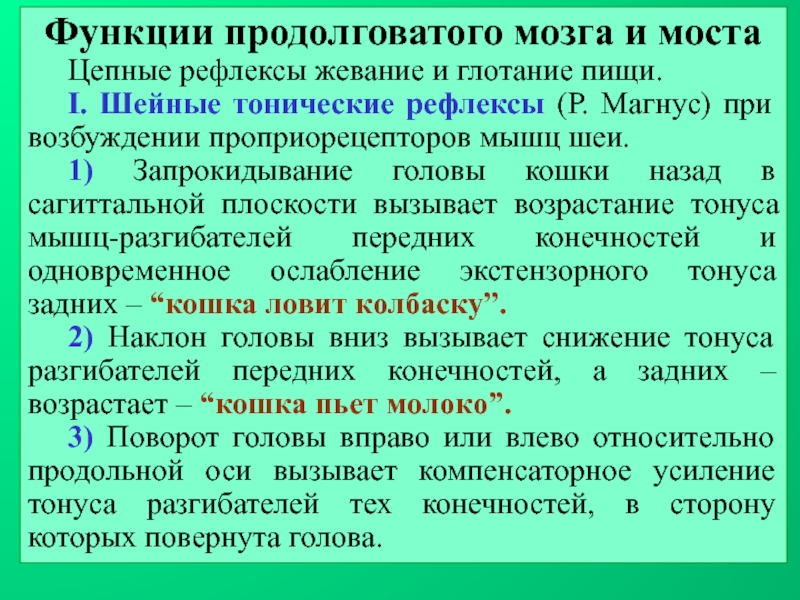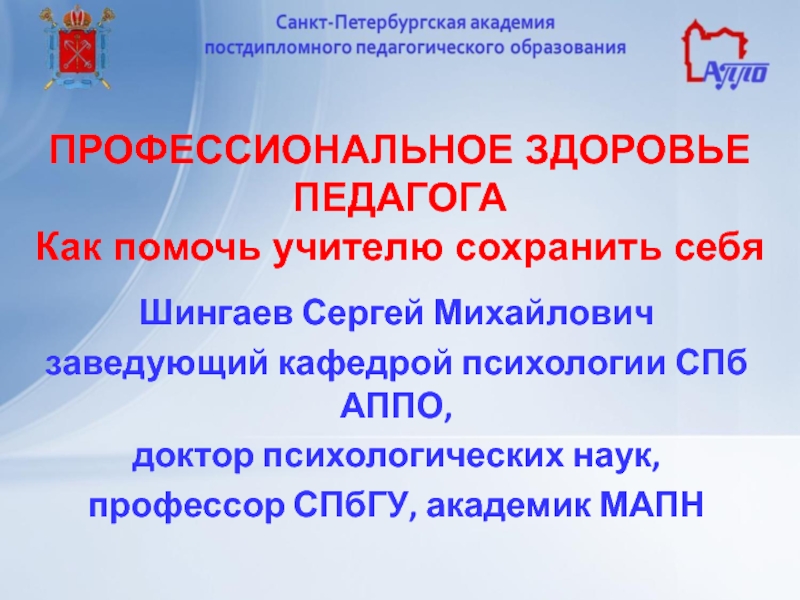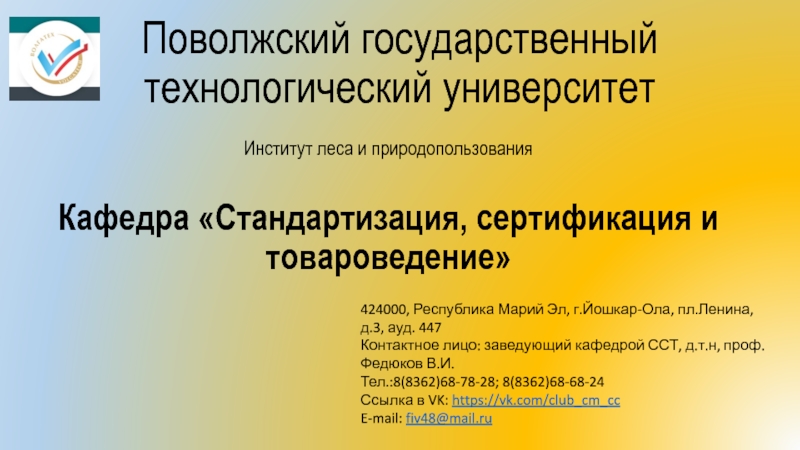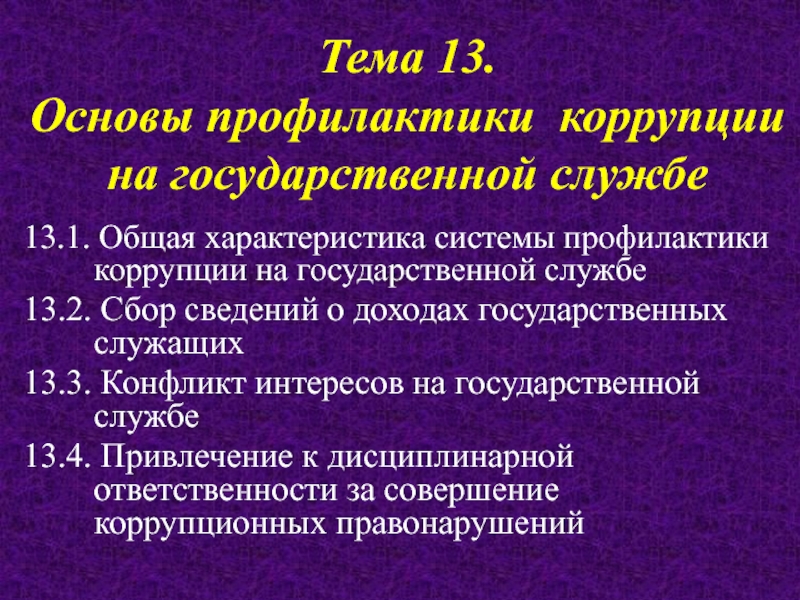Слайд 1Penza State University
Medical Institute
Department of History of Medicine
Course Paper In
(
Virginia Apgar [19091-1974] )
(Anesthesiologist Who Devised The Apgar Score Used
After Childbirth )
Name : Seyam Mahmoud Ahmedٍ .
Group : 19lC2a.
Year : First Year.
Doctor : Gavrilova Tatiana.
Penza 2020
Слайд 2Contents:
How is Virginia apgar . (3)
Early life and education. (3)
3- Work and research. (4)
Honors and awards. (8)
Death. (9)
Reference. (10)
Слайд 3How is Virginia Apgar .
"Nobody, but nobody, is going to
stop breathing on me!"
Virginia Apgar (June 7, 1909 – August
7, 1974) was an American obstetrical anesthesiologist, best known as the inventor of the Apgar Score, a way to quickly assess the health of a newborn child immediately after birth in order to combat infant mortality. She was a leader in the fields of
anesthesiology and teratology, and introduced obstetrical considerations to the established field of neonatology.
Early life and education.
The youngest of three children, Apgar was born and raised in Westfield, New Jersey, the daughter of Helen May (Clarke) and Charles Emory Apgar. Her father was a business executive and amateur astronomer whose amateur radio work exposed an enspionage ring during World War I. Her older brother died early from tuberculosis, and her other brother had a chronic illness. She graduated from Westfield High School in 1925, knowing that she wanted to be a doctor.
Apgar graduated from Mount Holyoke College in 1929, where she studied zoology with minors in physiology and chemistry.In 1933, she graduated fourth in her class from Columbia University College of Physicians and Surgeons (P&S) and completed a residency in surgery at P&S in 1937.
She was discouraged by Allen Whipple, the chairman of surgery at Columbia- Presbyterian Medical Center, from continuing her career as a surgeon because he had seen many women attempt to be successful surgeons and ultimately fail. He
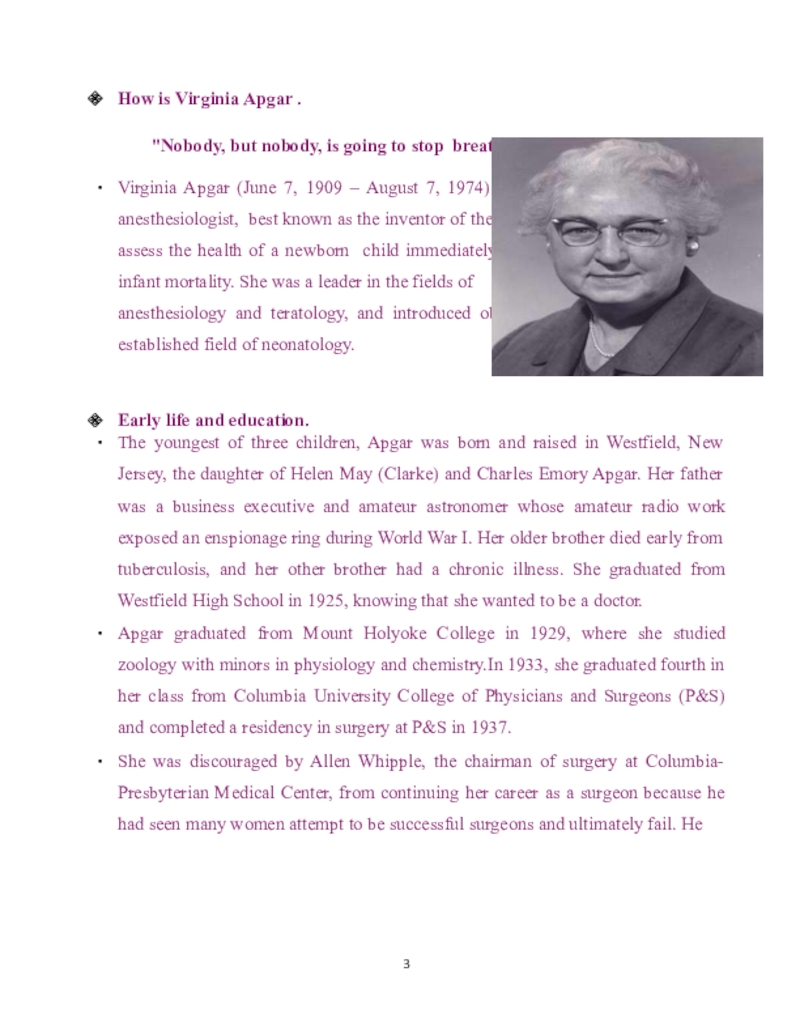
Слайд 4instead encouraged her to practice anesthesiology because he felt that
advancements in anesthesia were needed to further advance surgery and
felt that she had the "energy and ability" to make a significant contribution. Deciding to continue her career in anesthesiology, she trained for six months under Ralph Waters at the University of Wisconsin–Madison, where he had established the first anesthesiology department in the United States. In a 1937 photograph of Waters and his residents, she is the only woman among Waters and fifteen other men. She then studied for a further six months under Ernest Rovenstine in New York at Bellevue Hospital. She received a certification as an anesthesiologist in 1937,and returned to P&S in 1938 as director of the newly formed division of anesthesia.She later received a master's degree in public health at Johns Hopkins School of Hygiene and Public Health, graduating in 1959.
Work and research:
Apgar was the first woman to head a specialty division at Columbia-Presbyterian Medical Center (now NewYork–Presbyterian Hospital) and Columbia University College of Physicians and Surgeons. In conjunction with Allen Whipple, she started P&S's anesthesia division. She was placed in charge of the division's administrative duties and was also tasked with co-ordinating the staffing of the division and its work throughout the hospital. Throughout much of the 1940s, she was an administrator, teacher, recruiter, coordinator and practicing physician.[5]
Dr. Virginia Apgar, standing, facing right, examining baby with stethoscope. Virginia Apgar examining a newborn baby in 1966It was often difficult to find residents for the program, as anesthesiology had only recently been converted from a nursing specialty to a physician specialty. New anesthesiologists also faced scrutiny from other physicians, specifically surgeons, who were not used to having
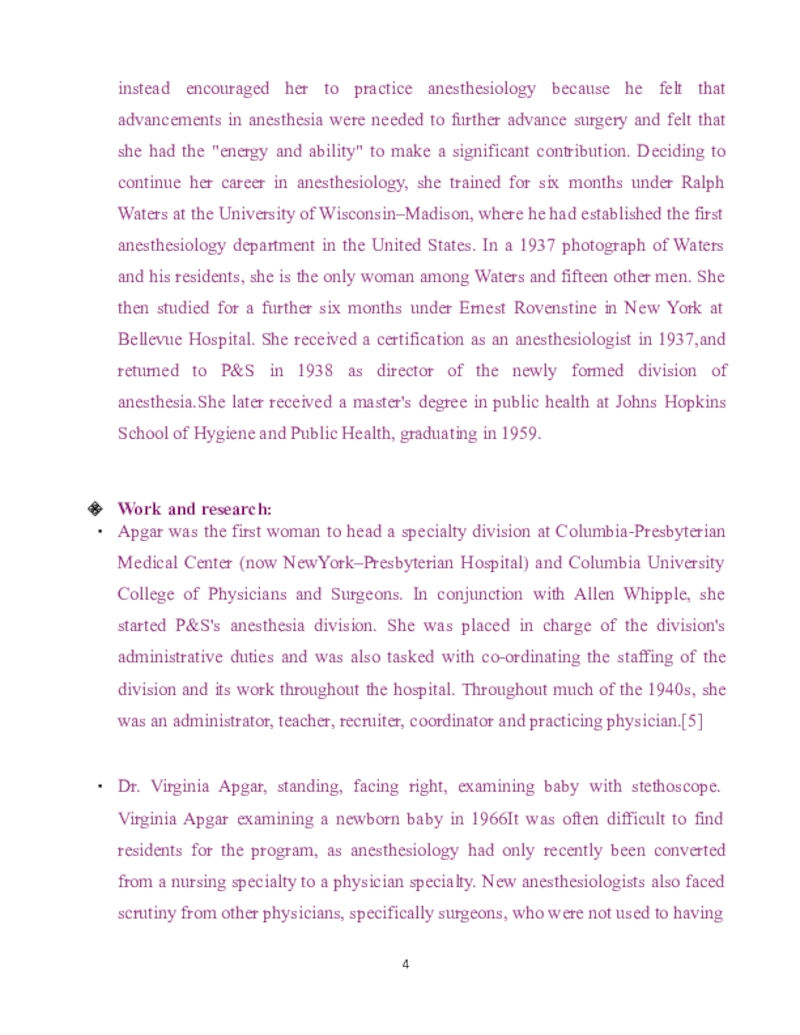
Слайд 5an anesthesia-specialized MD in the operating room. These difficulties led
to issues in gaining funding and support for the division.
With America's entrance into World War II in 1941, many medical professionals enlisted in the military to help the war effort, which created a serious staffing problem for domestic hospitals, Apgar's division included.
When the war ended in 1945, interest in anesthesiology was renewed in returning physicians, and the staffing problem for Apgar's division was quickly resolved. The specialty's growing popularity and Apgar's development of its residency program prompted P&S to establish it as an official department in 1949. Due to her lack of research, Apgar was not made the head of the department as was expected and the job was given to her colleague, Emmanuel Papper. Apgar was given a faculty position at P&S.
In 1949, Apgar became the first woman to become a full professor at P&S, where she remained until 1959. During this time, she also did clinical and research work at the affiliated Sloane Hospital for Women, still a division of NewYork – Presbyterian Hospital. In 1953, she introduced the first test, called the Apgar score, to assess the health of newborn babies.
Between the 1930s and the 1950s, the United States infant mortality rate decreased, but the number of infant deaths within the first 24 hours after birth remained constant. Apgar noticed this trend and began to investigate methods for decreasing the infant mortality rate specifically within the first 24 hours of the infant's life. As an obstetric anesthesiologist, Apgar was able to document trends that could distinguish healthy infants from infants in trouble.

Слайд 6his investigation led to a standardized scoring system used to
assess a newborn's health after birth, with the result referred
to as the newborn's "Apgar score". Each newborn is given a score of 0, 1 or 2 (a score of 2 meaning the newborn is in optimal condition, 0 being in distress) in each of the following categories: heart rate, respiration, color, muscle tone and reflex irritability. Compiled scores for each newborn can range between 0 and 10, with 10 being the best possible condition for a newborn. The scores were to be given to a newborn one minute after birth, and additional scores could be given in five-minute increments to guide treatment if the newborn's condition did not sufficiently improve. By the 1960s, many hospitals in the United States were using the Apgar score consistently. In the 21st century, the score continues to be used to provide an accepted and convenient method for reporting the status of the newborn infant immediately after birth .
In 1959, Apgar left Columbia and earned a Master of Public Health degree from the Johns Hopkins School of Hygiene and Public Health. From 1959 until her death in 1974, Apgar worked for the March of Dimes Foundation, serving as vice president for medical affairs and directing its research program to prevent and treat birth defects.
As gestational age is directly related to an infant's Apgar Score, Apgar was one of the first at the March of Dimes to bring attention to the problem of premature birth, now one of the March of Dimes' top priorities. During this time, she wrote and lectured extensively, writing articles in popular magazines as well as research work. In 1967, Apgar became vice president and director of basic research at The National Foundation-March of Dimes.
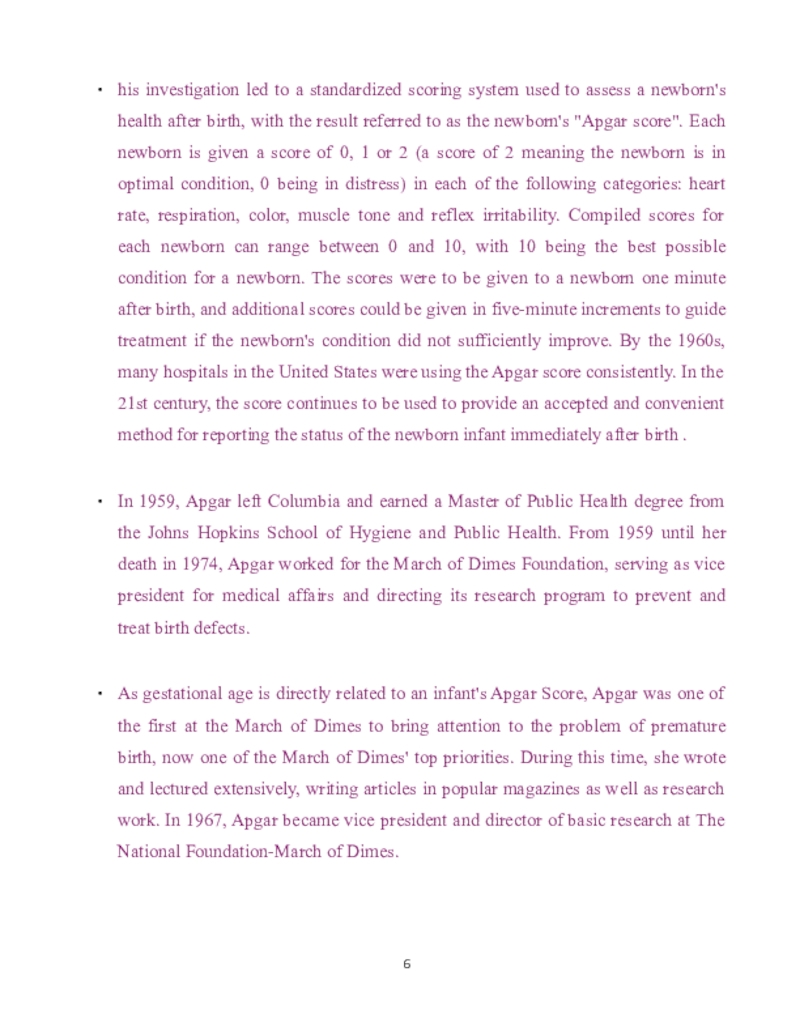
Слайд 7During the rubella pandemic of 1964–65, Apgar became an advocate
for universal vaccination to prevent mother-to-child transmission of rubella. Rubella
can cause serious congenital disorders if a woman becomes infected while pregnant. Between 1964 and 1965, the United States had an estimated 12.5 million rubella cases, which led to 11,000 miscarriages or therapeutic abortions and 20,000 cases of congenital rubella syndrome. These led to 2,100 deaths in infancy, 12,000 cases of deafness, 3,580 cases of blindness due to cataracts and/or microphthalmia and 1,800 cases of intellectual disability. In New York City alone, congenital rubella affected 1% of all babies born at that time.
Apgar also promoted effective use of Rh testing, which can identify women who are at risk for transmission of maternal antibodies across the placenta where they may subsequently bind with and destroy fetal red blood cells, resulting in fetal hydrops or even miscarriage.
Apgar traveled thousands of miles each year to speak to widely varied audiences about the importance of early detection of birth defects and the need for more research in this area. She proved an excellent ambassador for the National Foundation, and the annual income of that organization more than doubled during her tenure there. She also served the National Foundation as Director of Basic Medical Research (1967–1968) and Vice-President for Medical Affairs (1971– 1974). Her concerns for the welfare of children and families were combined with her talent for teaching in the 1972 book Is My Baby All Right?, written with Joan Beck.
Apgar was also a lecturer (1965–1971) and then clinical professor (1971–1974) of pediatrics at Cornell University School of Medicine, where she taught teratology
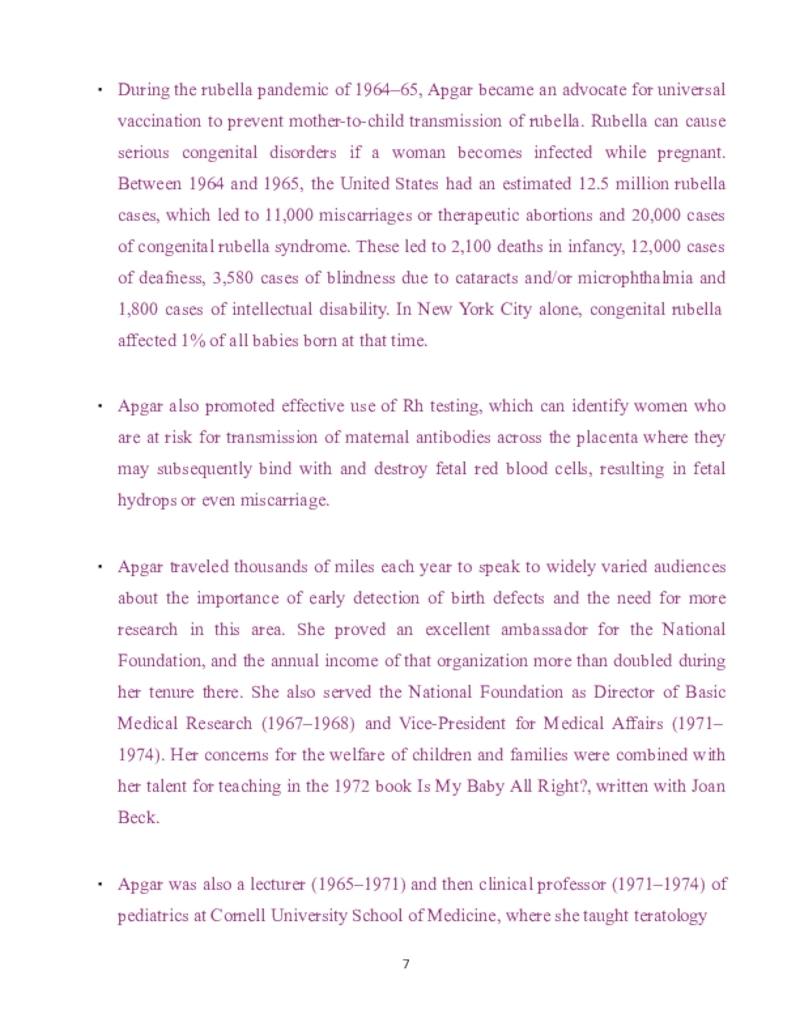
Слайд 8(the study of birth defects). She was the first to
hold a faculty position in this new area of pediatrics.
In 1973, she was appointed a lecturer in medical genetics at the Johns Hopkins School of Public Health.
Apgar published over sixty scientific articles and numerous shorter essays for newspapers and magazines during her career, along with her book, Is My Baby All Right?. She received many awards, including honorary doctorates from the Woman's Medical College of Pennsylvania (1964) and Mount Holyoke College (1965), the Elizabeth Blackwell Award from the American Medical Women's Association (1966), the Distinguished Service Award from the American Society of Anesthesiologists (1966), the Alumni Gold Medal for Distinguished Achievement from Columbia University College of Physicians and Surgeons (1973) and the Ralph M. Waters Award from the American Society of Anesthesiologists (1973). In 1973 she was also elected Woman of the Year in Science by the Ladies Home Journal.
Apgar was equally at home speaking to teens as she was to the movers and shakers of society. She spoke at March of Dimes Youth Conferences about teen pregnancy and congenital disorders at a time when these topics were considered taboo.
Honors and awards:
Honorary doctorate, Women's Medical College of Pennsylvania (1964)
Honorary doctorate, Mount Holyoke College (1965)
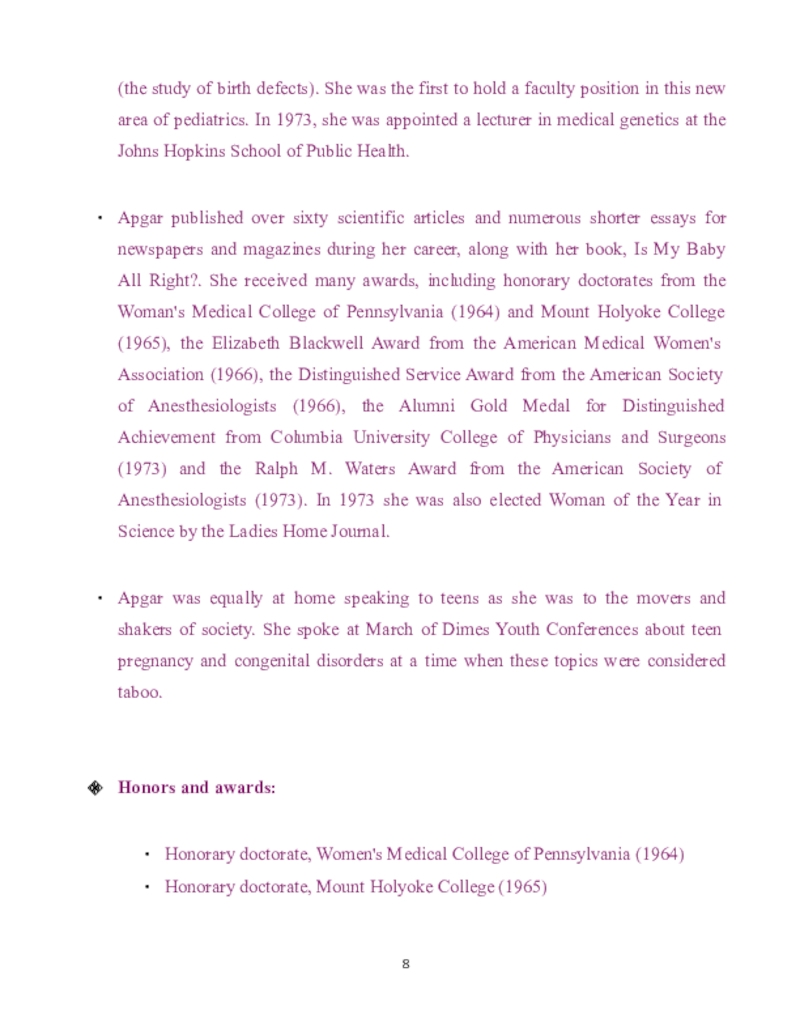
Слайд 9Distinguished Service Award from the American Society of Anesthesiologists (1966)
Elizabeth
Blackwell Award, from the American Women's Medical Association (1966)
Honorary doctorate,
New Jersey College of Medicine and Dentistry (1967)
Alumni Gold Medal for Distinguished Achievement, Columbia University College of Physicians and Surgeons (1973)
Ralph M. Waters Award, American Society of Anesthesiologists (1973)
Woman of the Year in Science, Ladies Home Journal (1973)
Fellow of the New York Academy of Medicine, the American Public Health Association, and the New York Academy of Sciences.
Death:
Apgar never married or had children, and died of cirrhosis[15] on August 7, 1974, at Columbia-Presbyterian Medical Center. She is buried at Fairview Cemetery in Westfield.
Слайд 10Reference:
https://en.wikipedia.org/wiki/Virginia_Apgar
https://cfmedicine.nlm.nih.gov/physicians/biography_12.html
https://journals.lww.com/anesthesia-
analgesia/Fulltext/2015/05000/Dr Virginia_Apgar_and_the_Apgar_Score__ How_the.23.aspx
https://www.marchofdimes.org/news/march-of-dimes-honors-100th- anniversary-of-virginia-apgar.aspx
5-
https://profiles.nlm.nih.gov/spotlight/cp/feature/biographical
https://en.wikipedia.org/wiki/Women_in_World_History
https://pubmed.ncbi.nlm.nih.gov/11242930/
http://c250.columbia.edu/c250_celebrates/remarkable_columbians/virginia_a pgar.html
![Презентация на тему Penza State UniversityMedical InstituteDepartment of History of MedicineCourse Penza State UniversityMedical InstituteDepartment of History of MedicineCourse Paper In( Virginia Apgar [19091-1974] )(Anesthesiologist Who Devised The](/img/tmb/7/622180/a10c9e2668b4bcdfac3befa82158482a-800x.jpg)







